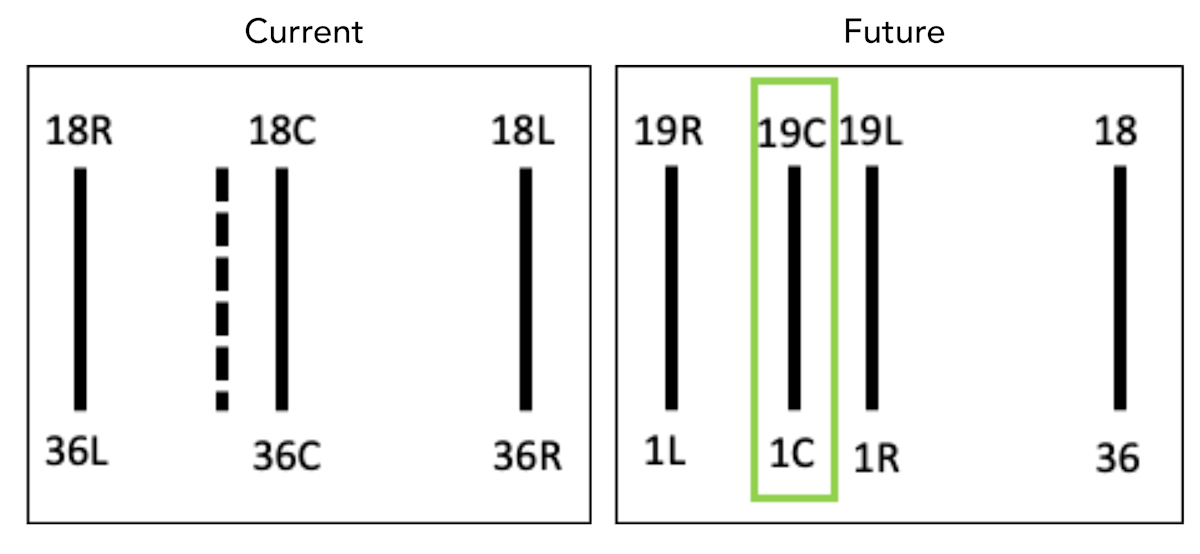What's In A Number? CLT's New Fourth Parallel Runway 1C-19C
When the new 10,000-foot Fourth Parallel Runway opens at Charlotte Douglas International Airport (CLT) in the fall of 2027, it will join three existing parallel runways, all of which run in a north-south direction.
Currently, CLT has Runways 18R-36L, 18C-36C and 18L-36R.
However, from May 2026 through September 2026, all three current runways will be renumbered.
This change is being made for system-wide consistency, safety and compliance with FAA standards and regulations. The timeline also gives pilots enough time to adjust to the changes and for aviation charts to be updated and synchronized—a process that happens every 56 days.
Changing the runway numbers takes a lot of time and manpower. Besides repainting the new numbers—which are 60 feet tall and 20 feet wide depending on the digits—CLT Airfield Maintenance and contractors must update over 120 physical markings and replace dozens of signs. Airside Operations makes sure everything meets standards.
The Challenge Of Parallel Runways
Why are these enormous white markings so important? The numbers offer both a visual cue for pilots and a cross-reference with cockpit instruments, ensuring they are aligned with the correct runway.
“It is a requirement for precision runways at commercial airports like CLT and assists pilots during poor weather and limited visibility,” said Trent Sellers, CLT Airport Planning Project Coordinator.
While multiple parallel runways are common at busy airports (CLT is currently ranked 6th worldwide for aircraft operations), they present specific challenges.
Because only three runways in the same orientation can be designated as Left, Center or Right, CLT’s fourth parallel runway needed a new designation to prevent confusion or errors for pilots and air traffic controllers.
Therefore, it has been adjusted by one digit (ten degrees), along with the two existing runways on either side. The fourth parallel will be designated Runway 1C-19C. The airport's original runway (18L-36R) will keep the same magnetic heading but will now be called Runway 18-36.
Here’s what the changes will look like:
- Runway 18R-36L becomes 1L-19R
- Fourth Parallel 1C-19C
- Runway 18C-36C becomes 1R-19L
- Runway 18L-36R becomes 18-36

How are they numbered? Think of a compass.
The most straightforward explanation of runway numbering is to think of a compass and the nearest magnetic headings: 360 degrees is north, 90 degrees is east, 180 degrees is south, and 270 degrees is west.
-
Runway numbers designate which direction the runway is pointing and go from 1 to 36.
-
To name a runway, you round it to the nearest ten-degree magnetic heading and remove the last zero.
-
For example, if the runway is closest to 360 degrees on a compass, it becomes Runway 36 (pronounced three six), 180 becomes Runway 18 (pronounced one eight), 190 becomes Runway 19 (pronounced one nine), etc.
-
The letter designation of L, R or C stands for Left, Right or Center and further differentiates parallel runways.
-
The reciprocal end of a runway will always be 180 degrees opposite.
Other Airfield Changes
Other recent changes on the airfield include the new North End Around Taxiway (NEAT) and South End Around Taxiway (SEAT), which will enable aircraft to avoid crossing an existing runway, and the new Fourth Parallel Runway, which will enhance airfield safety and operational efficiency.
And if you’re wondering whether a Fifth Parallel Runway might ever be built at CLT, it's possible. On the current Airport Layout Plan, it would be constructed on land east of the Air National Guard base, just west of Billy Graham Parkway—but that is likely decades away.

